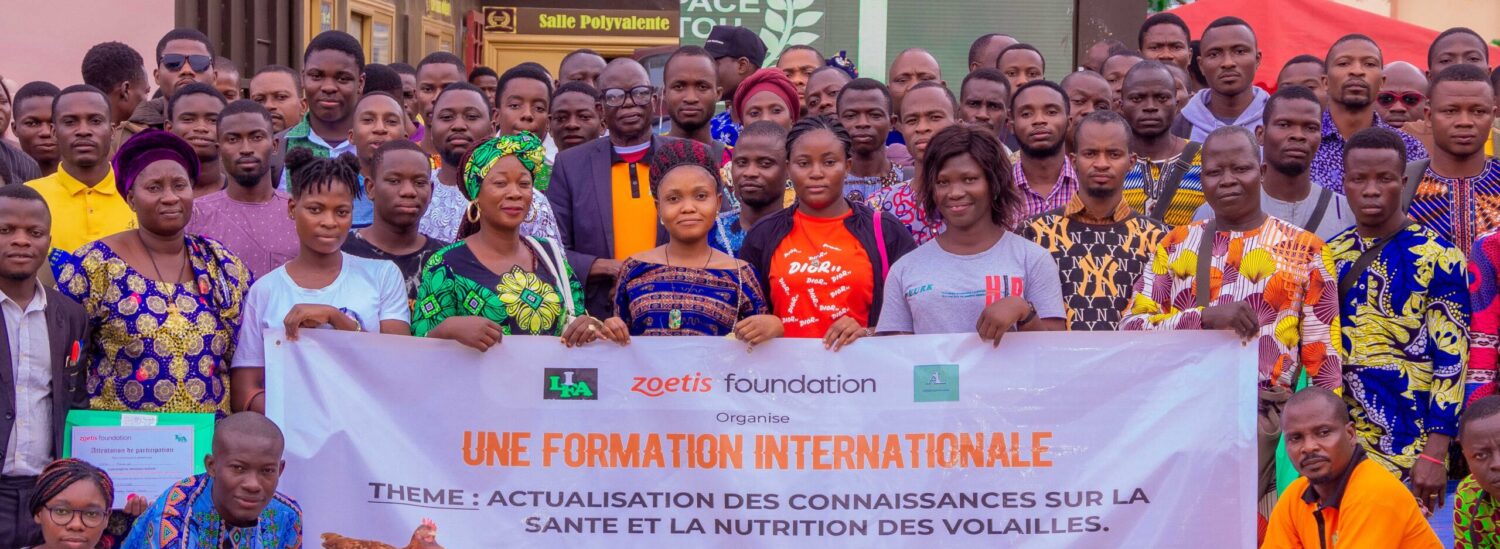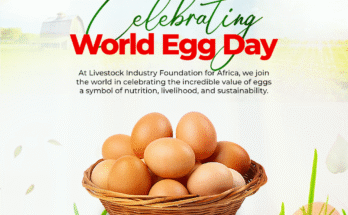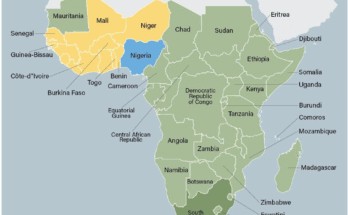“Every holiday, I go back to analyze my data and they come out with beautiful information that can be interventions and provide solutions to issues in the industry as at then which was not as sophisticated as it is now.” Dr. Stephen Adejoro

Dr. Stephen Oluwole Adejoro (SA): I was actively practicing veterinary medicine in South-West Nigeria and I was very pressed about documenting cases and data. I was just documenting them. I was just putting them on record. One night, specifically in August 1984, I had a dream and God told me, “All those data you are keeping, you must not lose them, because they would be useful in future.” There is a story behind every glory. Now is the time to tell the story. I was keeping the data. Every holiday, I go back and analyze my data and they come out with beautiful information that can be interventions and provide solutions to issues in the industry as at then which was not as sophisticated as it is now. That brought out the writing of books that were very useful to help farmers in this part of the world. There was no internet then, so farmers could read the books. and that was how it started. It was on for a very long time.
I produced a lot of papers, scientific papers which were read within the country and outside Nigeria until sometime in 2014 when I was in Toulouse, France to present a paper on data interpretation of Marek’s disease outbreak in humid tropical climate. And that data caught the passion of a company in France, Oufris in France. The interpretation of my study then was that hatcheries should not be held absolutely responsible for compensation when there’s an outbreak of Marek’s disease. The notion was that if you have vaccination at the hatchery, the birds are safe, they have solid immunity and they are not supposed to come down. But that’s not what we were finding outside. We found that after 12 weeks, about 3months, outbreaks sometimes occur. And the farmer goes back to the hatchery to start demanding for compensation. And so my study, which was 20 years of Marek’s research in Nigeria brought out clearly a traceability analysis that the vaccination done at the hatchery could break down. And it was not because the vaccination was not properly done, but because there were secondary challenges outside the hatchery. That was how we identified mycotoxins as the core reason why vaccinations were breaking down because the birds were subjected to sub-clinical levels of mycotoxins and that’s why you had outbreaks coming from the farm. From the study you can trace that the hatchery vaccination was successful because it can show you a pattern of mortality that is normal until about 12 months of age. So, this information caught a lot of awareness. And a farm in Nigeria, CHI was the first company to identify this problem and they called me to produce a training in 2005. And that was the training that brought out the ideas for us that we need to do a second vaccination for Marek’s that would look like an amnestic response. At that time, it became clear to me that all other data that I had, all of them I should now interpret them, bring them out and make them available for farmers all over the world. The idea of forming an NGO started coming up until finally in 2015, the lord spoke to me again. He said, “Go and help them develop livestock agriculture”. So that’s the mission. And then, I started looking for opportunities to form an NGO. I came across a daughter lawyer of mine who took it up and then we formed a company.
“Go and help them develop livestock agriculture”.
(SA): There are so many memorable experiences. I would tell you that as a young practitioner as far back as 1977, the first challenge I had was the problem of mycotoxins. In ‘77/78, finished feeds were still imported into Nigeria. There was a particular occasion when finished feed was imported into Nigeria from Germany. And you know it would take about 3months for it to get to Nigeria, and there was serious mycotoxin contamination. There were mold and aflatoxins and that batch of feed killed about 66,000 birds somewhere in Nigeria. I was involved in writing a report on that. That was the first time I started appreciating teamwork. I was out of the University, into practice as at then and the products were brought to me. I co-opted some colleagues of mine in nutrition and toxicology. I asked the nutritionist, late Dr. Ogundola to go and do a proximate analysis of the feed for me. I asked a toxicologist, Prof Ogbonike. We found out that nutritionally; proximate analysis of the feed was okay, but there was heavy contamination of aflatoxins. I did my own part.
I had experimental birds that I fed, and I found that production was stagnant among many other factors. I joined all these factors together, and I wrote to the company, to the people who brought it to me. That report gave me a lot of tussle, because it led to a court case, and that retarded my practice as a young veterinarian for so many years. But we thank God; we were able to solve it. But that’s a big challenge for someone just coming into practice. I thought I was doing practice but I didn’t note the legal aspect of practice at that time. So that was the first challenge I had.The second challenge I had was the challenge of Gumboro disease. The only lecture I had about it in the University was that “This disease is not in Nigeria.” Just about three sentences. But when I came out to practice, it was the greatest challenge that I had. Farmers were complaining, birds were dying and I started doing research on how we could minimize it, importing my knowledge from virology and bringing it to bear. We were able to use it to minimize mortality and drastically reduce mortality instead of telling the farmer that the disease is self-limiting, that he should just fold his hands and watch 30-40% of his birds dying. I had a lot of criticism at that time too. So that was also a challenge.
It was also a challenge for you to just come out and say it’s research you want to be doing when people are looking for money. But today I thank God that that was my vision because he said “seek ye first the kingdom of God and all other things shall be added unto you.” Now that we have collated all our research findings, it now becomes a story that would be available to many farmers not only in Nigeria but all over the world. These experiences led to some of the solutions we are packaging for LIFA today.
“It was also a challenge for you to just come out and say it’s research you want to be doing when people are looking for money.”
(SA): Logistics challenge, funding challenge, but God gave us the ability to overcome them. We came to a conclusion that the major health challenge in tropical poultry production is mycotoxin. And unfortunately, farmers in Africa are looking the other way, spending a lot of money on antibiotics treatment and paying less attention to mycotoxins. Why did I say this? I found out that in all the departments or segments of the livestock industry from the upstream to the downstream, to the table of the consumer, mycotoxin plays a vital role. Mycotoxin in GPS breeders can be vertically transmitted to the offspring; the offspring can carry toxins that manipulate or suppress their immune system, causing a lot of resistance and which the farmer would look at and incur more cost to manage opportunistic infections that occur on the way. So, if the farmer is aware that he should put his money to manage mycotoxins, he would manage a lot of the diseases that are found in his farm. So, we’re passionate to want to team up with different sectors of the livestock food chain that are playing a role in controlling aflatoxin. And that’s what we have been doing. We have been talking with people that produce afla-safe maize, we’re talking with nutritionists that are in charge of seeing that the feed is not contaminated. We’re also looking at mycotoxins in the physiology, pathogenesis and epidemiology of the animal system. And I keep on mentioning mycotoxins though aflatoxin is the core issue that the Government is concerned about.
The major problems we have in the industry are the large molecule toxins, that is, the fuminosins, the zearalenones and the ochratoxins. These toxins can cause non-specific antibody production and that means that if a farmer goes to vaccinate for Newcastle Disease, his chickens can produce antibodies to IB, and that has been wasted. Again, zearalenone for example, mimics oestrogen. The structure of zearalenone is like oestrogen. This is a hormone and it is dangerous for veterinarians and nutritionists to close their eyes to these toxins, because they do compete with the receptive sites that oestrogen would attach to in the system. And when they do that, the cell runs signals to the reproductive system, and you start seeing all manner of infections, including pyometra. So, control mycotoxins and you control a large proportion of infection. We did a study sometime and found that it would cost about 45 million dollars to treat 40 million layer-birds in Nigeria with antibiotics in the country. That translates to about 1,750 naira per chicken. That’s a lot of money. And the cause of this is resistance development.
Another study we did showed the level of resistances we had to the major bacterial diseases of poultry. Colibacillosis is about 75% resistant and then for Salmonella we have only 8% resistance development. And we did the same thing for others and compared with 20 different antibiotics in the market and we were having 75% resistances to 20 different antibiotics in the market, so this kind of study shows that we need to focus on other reasons that minimize antibiotic treatment. This is the reason for my passion on mycotoxins.

(JN): Your website mentions your advocacy for national inclusion of LEGS (Livestock Emergency Guideline and Standard). Can you shed more light on the significance of LEGS?
We want LEGS to be used by NEMA to compensate farmers when there is a livestock disaster. It’s not only just for men. What of the livestock that are lost? And how can the people restart their business and their livelihoods? We are passionate on that and I had a training on that in Senegal.
To bring my point home, for example look at glut. One of the greatest ways we can manage glut in Nigeria is just to supply a segmented market. You see, when an egg producer has another place he can sell his eggs too, then less eggs would come to the market just for consumers to buy for cooking or frying. So, value would be added to the egg and the value-added egg, either powder or liquid can be eaten outside Nigeria with a long shelf life. This market is lacking, and if there had been advocacy, this matter would have brought to the attention of some investors that would want to add that kind of value to the egg market in Nigeria.
It’s the responsibility of the NGO to convince the Government, and dialogue with the Government, and make noise about it. These are the things we are missing. We’re also missing a lot of NGO grants that can create employment opportunities and work for our youth. An NGO is supposed to work alongside Government and provide alternative opportunities for people. Not everyone should be looking directly upon the Government. That’s what we’re lacking.

So, our point is this: why don’t you remodify this policy and allow us to have vaccination for our GPS and our parent stock. This way, you would have vertical immune response and antibodies would then go downstream. Again, if you say there’s an outbreak, you can have a regulated vaccination: where the outbreak occurred, do a ring vaccination, not around the country but around where the outbreak occurred. And not going to where the outbreak occurred and start vaccinating outwards, which was a big problem that was done in the past. These are the things that we packaged together that we think we should dialogue with government, not in confrontation but dialogue to see if this can be adopted. If this is adopted, the government can hands-off on compensating because they will now ask insurance companies to insure them. Then you now mark that the vaccination policy. but this vaccination must not be like other vaccinations going on in the country. It must only be guaranteed by government approval, the kind and the type of vaccine to be brought into the country and it cannot be brought into the country without the approval of the Directorate of Veterinary Services. That’s my concern and not just anyone should import the vaccine. It must be identified by the kind that is suitable, and it must be approved by the Government and only then can anybody bring it in. That is the stand of our NGO as far that is concerned.
“Eleru lo ma ngberu e. Wa a koko gberu e na”
This program was ongoing in Osun state, but inadequate funds did not allow them to continue with it. At least they started it. That’s one initiative on our hands.
How did I come about that? I practiced it myself and it was this practice I used to train all my children in school. I practiced it on a small scale using a portion of land at the back of my house, on a 2-plot area and I was able to keep the stock of 25 Sokoto Gudali breed of cattle. It’s humped cattle with very short or no horns at all, and it’s good for meat. We were able to keep it, and people were coming here to the house to buy it. The poultry would bring money on a daily basis because they are laying eggs, and the cattle would be an investment because it appreciates on a daily basis. You can even use the cattle as collateral if you are in a cooperative to take more loans. So, this is an initiative we have for empowerment programs. As I’m talking to you now, we’ve started talking to some people about this, about how we can get this started in South-Western Nigeria. That is one initiative. We’ve published a book on that. The book I authored on that has been published by Lambert publishers in Germany and sold on Amazon, so you can Google it if you’re interested. We intend to use this book massively for this program. Meanwhile, we are intending that royalties that come from the book will help the NGO expand her activities.

Then again, we also have other initiatives, such as researching causes for vaccination failure and then documenting them. All the initiatives are well spelled out on our website, so you can visit it and see them.
I fenced the back of my house with wood, created feeders, created troughs and I made a lairage and in 6,7 months they were big enough. As I was selling them, I was replacing them until my stock was replenished.


This continued until 1984 when I wrote a book on that, I granted an interview to a newspaper. The late Governor of Oyo state, Oyakhire saw the interview, and he asked the commissioner of agriculture to come and verify whether it was true or not. The commissioner at that time was late Dr. Adegoke. He invited me to his office and I went there. He doubted that I could keep such number of cattle and he said he wanted to see it. So he came, and when he entered and looked at them, he said, “Oh, so it’s possible”. He then asked me at that time to follow him to Oke-Ogun, the savannah part of Oyo state which was my target at that time that we develop as the cattle capital of Oyo state. But unfortunately, we could not continue with that. But I continued with my passion to the extent that I wrote a brilliant paper on how Oke-Ogun should be turned to cattle producing area in Oyo state. You can Google that today: “The Goal of Veterinarians in Livestock Development.” I specifically challenged them that every resource you need to do cattle fattening pogram is in Oke-Ogun.
Every household in Igbeti, in Saki, all those areas have abundant waste resources of guinea corn and other things that you can use. All you need to do is enclose an area where you can put these cattle, and put a feeder, and this can move the veterinarians from urban areas to rural areas to provide veterinary services if almost all the houses have two or three cattle at the back of their houses. Why would a nutritionist not go there and prepare some finished feed for them? This finished feed are needed because you put them on 2 kilograms of finished feed concentrates every day to prevent them from breaking the fence and causing nuisance all around. That ration is about 17% protein and contains about 1,815 calories of energy which can be made specifically for them. So, they can feed on this in the evening, so they would not break the fence. And in the day, they can feed on chaff and other raw materials. A house can have 2or 3 cattle and later if it is dairy that they want to have they can have it. This is the beautiful thing that can be done in Oke-Ogun, it can be done in Ikoyi area of Ondo state, Ilaro area of Ogun state, Ilogbo area of Osun state. We preach it but I hope one day Government would look at it and do it, this is the passion.








Well done sir. So proud of your work.
good job
Thank you Aylesworth for your recognition and